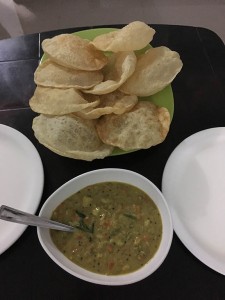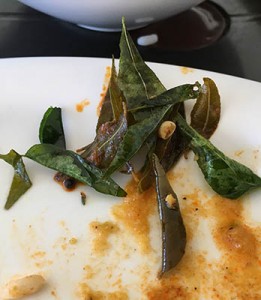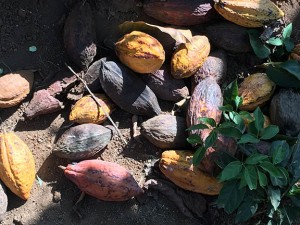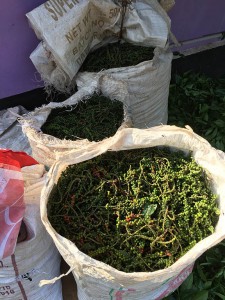What about food in India? I wouldn’t know since we’ve only been here for a short while, and most of it here in the hill country of the Western Ghats near Vagamon, Kerala. Since we’ve arrived at our mountain lodge, courtesy of Miriam’s residency at Palette People, the home-cooked meals we are being served here three times a day have provided not just nourishment but structure to our days. Breakfast is usually when we return from our morning walks, around 9:30am, lunch around 1:30, tea around 4, dinner 7:30. Breakfast is usually a warm dish of chickpeas in broth, either with “poota,” which is dry cream of wheat or something like it steamed in form of a log in a “poota-maker.” or with spongy, pan-cake-like flat breads that taste a little sour, or with a nest of thin pasta. Sometimes the morning or evening meal may be a thicker stew with hard boiled eggs. Lunch is the most elaborate meal of the day. It may include “sambar.” a kind of veggie stew with some stalky vegetables that have soft stuff inside, or fish-currie, or some other main dish, along with usually one dish of finely chopped cabbage fried, but served cold, a dish of fried potatoes and onions, and pickles. If there’s fish-currie then there’s also usually a kind of yogurt based gravy that helps soften the somewhat pungent taste of the fish-stew, which is spiced with a kind of tamarind. At night we eat something like poori masala, similar to the morning meal but with more variety. Usually there’s fresh chapati served in a warming dish.
Eating with our hands required some getting used to. I am still a messy eater, much to Miriam’s amusement (I hope). The experience is a little like playing with your food before eating it. After you’ve done this for a while, you no longer like for metal objects to come between your mouth and the food you’re eating. It’s a wholistic experience you don’t want to miss. Of course you only use your right hand. (The left is for other business.) I like crumbling papadum into the rice, which makes a satisfying noise and adds taste and texture to the meal (only at lunch).
The food is very different from what we usually think of as Indian food. The tastes are subtle, the textures complex. Almost everything is spiced with a handful of green currie-leafs that you’re supposed to fish out and discard. (Hence the local saying, “Don’t treat me like a currie-leaf.”) Our cook fries everything in sunflower seed oil with mustard seeds, lots of garlic, onion, green chili pepper, carrots, green beans, sometimes tomatoes. Masala is thickened with mashed potatoes and milk. Spices vary by dish and include garam masala, cumin, cardamom, cinnamon, and others.
Walking around the hills and getting to know what people grow in their gardens goes together with the cooking and the meals we have. We were able to appreciate the pieces of boiled tapioca that showed up on the menu one day because a few days earlier we had been shown a tapioca plant at someone’s orchard. We see the cows on our daily walks that (presumably) supply the milk for the locally grown coffee and tea. We buy bananas in the shop in Uluppuni that the shop-keeper or his neighbor cultivates in his plantation. The bananas, btw, are to die for. The larger ones are orange on the inside, the smaller ones white. Picked when ripe, the fruit is firm and sweet, and very satisfying. Some people grow pineapple, mango, and citrus fruit. There are tall coconut in lower lying areas and small date palms dot the grassland.
We’ve seen giant green beans, soy beans, cocoa fruit, eggplant, and other cultivated crops. There are “jack-fruit” trees, with green lumps that are picked in July and are supposedly supposedly delicious to eat and used in a variety of ways. There are medicinal plants, tree nuts (cashew, pecan), passion fruit, guava, and all sorts of nuts, leafs, and fruit with intoxicating qualities.
Cocoa is harvested from the seeds of the cocoa fruit. Miriam brought some of the fruit back to draw, and one of the assistants here explained how you get to the desired parts. The seeds are covered in some white film that you suck off, then let the beans dry. To get to the inside, where the black flaky stuff resides that is the base for chocolate, you need to crack open the brown husk of the seed. By itself cocoa tastes a bit chalky but it’s very good and obviously not sweet at all, really more like the essence of dark chocolate. One can understand (says Miriam) why the Mexicans cook with cocoa, which takes the fruit in a completely different direction.






